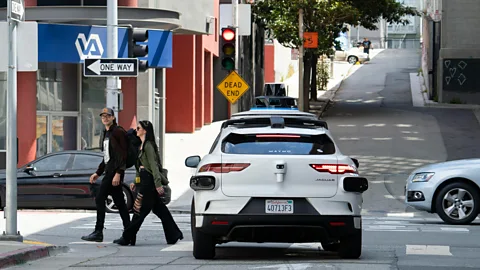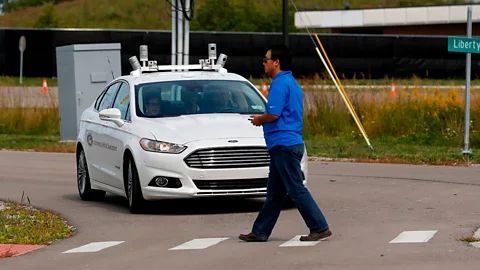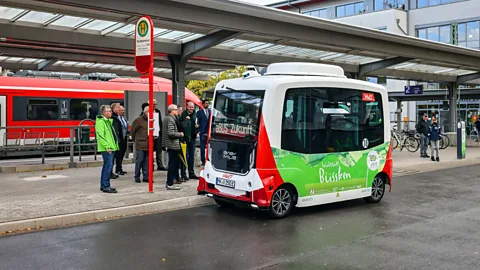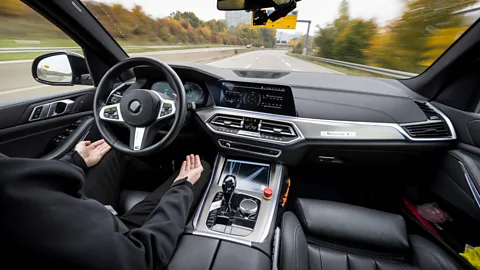How driverless cars will change our world
 Alamy
AlamySelf-driving vehicles are steadily becoming a reality despite the many hurdles still to be overcome – and they could change our world in some unexpected ways.
It's a late night in the Metro area of Phoenix, Arizona. Under the artificial glare of street lamps, a car can be seen slowly approaching. Active sensors on the vehicle radiate a low hum. A green and blue 'W' glows from the windscreen, giving off just enough light to see inside – to a completely empty driver seat.
The wheel navigates the curb steadily, parking as an arrival notification pings on the phone of the person waiting for it. When they open the door to climb inside, a voice greets them over the vehicle's sound system. "Good evening, this car is all yours – with no one upfront," it says.
This is a Waymo One robotaxi, hailed just 10 minutes ago using an app. The open use of this service to the public, slowly expanding across the US, is one of the many developments signalling that driverless technology is truly becoming a part of our lives.
The promise of driverless technology has long been enticing. It has the potential to transform our experience of commuting and long journeys, take people out of high-risk working environments and streamline our industries. It's key to helping us build the cities of the future, where our reliance and relationship with cars are redefined – lowering carbon emissions and paving the way for more sustainable ways of living. And it could make our travel safer. The World Health Organization estimates that more than 1.3 million people die each year as a result of road traffic crashes. "We want safer roads and less fatalities. Automation ultimately could provide that," says Camilla Fowler, head of automated transport for the UK's Transport Research Laboratory (TRL).
But in order for driverless technology to become mainstream, much still needs to change.
"Driverless vehicles should be a very calm and serene way of getting from A to B. But not every human driver around it will be behaving in that way," says David Hynd, chief scientist for safety and investigations at TRL. "It's got to be able to cope with human drivers speeding, for instance, or breaking the rules of the road."
And that's not the only challenge. There's regulation, rethinking the highway code, public perception, improving the infrastructure of our streets, towns, cities, and the big question of ultimate liability for road accidents. "The whole insurance industry is looking into how they're going to deal with that change from a person being responsible and in charge to the vehicle doing that," says Richard Jinks, vice president of commercial at Oxfordshire-based driverless vehicle software company Oxbotica, which has been testing its technology in cars and delivery vehicles at several locations across the UK and Europe.
The ultimate vision experts are working towards is of completely driverless vehicles, both within industry, wider transport networks, and personal-use cars, that can be deployed and used anywhere and everywhere around the world.
 Jeff Kowalsky/AFP/Getty Images
Jeff Kowalsky/AFP/Getty ImagesBut with all these hurdles in place, what exactly does the next 10 years have in store for autonomous vehicles?
Two years from now
The biggest hurdle for those in the driverless technology industry is how to get the cars to operate safely and effectively in complex and unpredictable human environments. Cracking this part of the puzzle will be the major focus of the next two years.
At the Mcity Test Facility at the University of Michigan, experts are addressing this. The world's first purpose-built testing ground for autonomous vehicles, it's a mini-town of sorts, made up of 16 acres of road and traffic infrastructure. It includes traffic signals and signs, underpasses, building facades, tree cover, home and garage exterior for testing delivery and ride-hailing, and different terrains such as road, pedestrian walkways, railway tracks, and road-markings which the vehicles must navigate. It's here that experts test scenarios that even the most experienced of drivers may be pressed to handle, from children playing in the street to two cars trying to merge on a junction at the same time.
Change Agents
We know the world has to change for humanity to thrive. But what are the most promising solutions that could provide the kind of transformation we need? In a world adjusting to the recent global pandemic, Change Agents examines innovations and technologies that could make our planet a better, healthier place to live.
"In order to test driverless technology like this, it depends on hundreds of different variables in any given situation," explains Necmiye Ozay, associate professor of electrical and computer engineering at the University of Michigan. Her solution is to create a group of varied thinkers.
"We're trying to bring people from different parts of the university – not only engineers, but we have people from across disciplines such as psychology, more human-machine-interaction type people, because there are lots of angles to this problem we are trying to solve when it comes to safety," says Ozay. In the facility, Ozay and her team can test different traffic scenarios, as well as explore how autonomous vehicles communicate with each other yet keep vehicle and personal data secure from hackers.
That self-driving taxis are already on the roads in Phoenix, Arizona, is due to a prolonged testing process like the one Ozay's team is conducting. Currently only available as a test service to the public in small defined areas, in the next two years there are plans to release the taxis on a greater and wider scale. For example, US-based company Waymo is currently rolling out to new city test sites that could very realistically see robotaxis operational in San Francisco and New York by 2023. But their co-chief executive Tekedra Mawakana was cautious to say what further roll out of its service there might be, and where, because "safety takes time".
AutoX, a start-up funded by Alibaba, launched its fully driverless RoboTaxi in Shanghai, China in 2020. By 2023 it's likely their service will be available in other cities across China, as well as in California.
Much of the driverless technology already in use exists in industrial settings like mines, warehouses, and ports, but Hynd believes in the next two years we can expect to see this extended to "last mile delivery". This means the final part of a journey for goods and services – the point at which they are delivered to the consumer. For example, autonomous HGV trucks on motorways or even delivery vehicles for products and groceries.
Five years from now
While Apple says it is aiming to launch fully self-driving electric cars four years from now, industry experts are more cautious about what the near-future holds.
According to Fowler, the conversation around regulation and insurance companies' new role within this transport space needs to mature. "It's got to be a very iterative approach where we're starting with pods and shuttles, or we're starting with off-highway vehicles where you can see such a benefit, and you've got a more controlled environment potentially, and what works with that," she says. "Then we can scale it up and across more vehicle types, more use cases."
 Alamy
AlamyOne new space we can expect to see driverless technology deployed in is high-risk environments, from nuclear plants to military settings, to limit the dangers to human life, says Fowler. A Rio Tinto mine in Western Australia, for example, is currently operating the largest autonomous fleet in the world. The trucks are controlled by a centralised system miles away in Perth.
"If you can take people out of that and you can have vehicles that are driving themselves, and are fully automated even, if you've got somebody who's remotely needing to control that vehicle in that high-risk environment then that's got to be good," says Fowler.
In the next five years most driverless technology will remain behind the scenes. TRL is investigating the potential for driverless HGVs on motorways, including the idea of platooning vehicles. Platoons are a group of semi-autonomous vehicles that drive a close distance between each other, stopping other vehicles from separating them. By driving closer together, vehicles in a platoon can be more fuel efficient by taking advantage of the slipstream of the truck in front while also helping to reduce congestion as the lorries take up less overall space on the road. Also in this space is Plus, the first self-driving truck manufacturer, whose European pilots commenced this year after a successful trial on Wufengshan highway in China's Yangtze Delta economic centre.
You might also like:
Away from these industries, Ozay further predicts that "we will possibly see lighter robotic vehicles that can potentially use sidewalks and bike paths with limited speeds – for delivering things such as food and groceries."
When it comes to public transport, Oxbotica is also working with German-based vehicle systems specialist ZF over the next five years to make the driverless shuttle a true mainstay for European cities, operating on roads, as well as at airports, much in the same way buses do now. "The shuttles in airports we see today on rails won't need those rails in five years from now. This means driverless shuttles have the potential to transport you from the car park to the airport, then straight through to your gate and the plane," Jinks explains.
For users, this could mean more reliable and cost-efficient transport systems. "Interlinking autonomous transport systems to bring a public transport system that is as efficient as you jumping in your own car and driving it yourself has got to be the answer to congestion in the future," adds Jinks.
Seven years from now
All experts agree that the next seven years will depend on the successes and failures of initial deployments, and how safety and public trust evolves accordingly. However, most hope that city redesigns will enable more adoption of the technology and help move us into modern, and more efficient ways of living. "If you live in a dense, urban area, the hope is that you'd be able to rely on mobility as a service. You could dial up the car, it would arrive in two minutes, and you make your journey. You wouldn't need to have those vast rows of parked cars in your street, which makes the street more navigable for the automated vehicle," says Hynd.
Without parked cars lining the street, roads could be narrower, making way for more green spaces. But while proponents of self-driving vehicles insist they will make our roads safer, there are some who feel pedestrians and autonomous vehicles simply can't mix. It could mean that our cities and the way we use them may need to be reimagined.
Some of this thinking is already taking place. In 2018, IKEA developed a concept autonomous vehicle that can double up as meeting rooms, hotels, and stores. The impact this type of innovation would have is reduced requirement for travel in the first place, offering instead interchangeable, on-demand environments as and when we need them. Our needs could be met right where we are.
Ozay expects many more self-driving options to be available for customers during this time, including in the passenger vehicle space. "My hope is that cars will be smart enough to say 'yes' or 'no' when asked if they can reliably and safely get a non-driver from point A to point B on a given day, by analysing the weather and traffic conditions beforehand," she explains.
10 years from now
Despite all the developments and innovations the next decade is likely to hold, some experts still feel we might be a way off from full deployment of driverless vehicles. By 2031, "full-self driving – human-level or above, in all possible conditions, where you can put kids by themselves in the car to send them to arbitrary locations without worrying – is not something I expect to see," says Ozay.
 Thomas Lohnes/AFP/Getty Images
Thomas Lohnes/AFP/Getty ImagesHynd agrees that full automation is unlikely on this timescale. "With anything transport infrastructure, anything that society uses, so many other things need to come into play. And I don't just mean regulation," he says. Safety will be a major hurdle, especially for countries slower to adopt the change because of the huge costs involved. Infrastructure will also dictate how fast and effectively this technology can roll out, and public perception and willingness to use autonomous vehicles will need to increase according to Hynd.
But not everyone agrees. Jinks is confident that we'll see autonomous vehicles on the roads at the same time as human-driven vehicles in 10 years from now. In this vein, you may very well be stepping onto a driverless shuttle at the airport, then into a self-driving taxi to take you to your final destination.
Owning a driverless car in the next 10 years is less likely – it'll still be too expensive for most people, according to Hynd. But the promise of driverless technology is about unchaining us from our reliance on cars, and how that can transform the use of our time and our environment.
"This is one of the biggest engineering problems that we're trying to solve in a century," Jinks says. "It will be an evolution over time from less complex environments and capabilities, to more complex, to everywhere. It's a continuum, and think about that continuum... It will keep improving over time. These things will continuously learn from each other."
Much in the same way that electric charging stations have slowly entered car parks, side streets, and service stations, so too will autonomous vehicles eventually make their way into our everyday worlds. Years from now, we may well be wondering how we ever lived without them.
--
